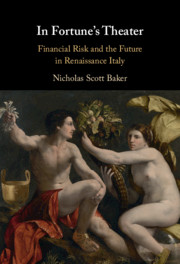Book contents
- In Fortune’s Theater
- In Fortune’s Theater
- Copyright page
- Contents
- Figures
- Preface
- Acknowledgments
- Note on the Text
- Introduction
- 1 Experts in Futurity
- 2 The Future in Play
- 3 Trust in the Future
- 4 The Mercantile Vocabulary of Futurity in Sixteenth-Century Italy
- 5 The Renaissance Afterlife of Boethius’s Moral Allegory of Fortuna
- 6 The Emerging of a New Allegory in Mercantile Culture
- 7 The Shifting Image of Fortuna
- 8 The Separation of Fortuna and Providence
- Conclusion
- Bibliography
- Index
3 - Trust in the Future
Published online by Cambridge University Press: 19 July 2021
- In Fortune’s Theater
- In Fortune’s Theater
- Copyright page
- Contents
- Figures
- Preface
- Acknowledgments
- Note on the Text
- Introduction
- 1 Experts in Futurity
- 2 The Future in Play
- 3 Trust in the Future
- 4 The Mercantile Vocabulary of Futurity in Sixteenth-Century Italy
- 5 The Renaissance Afterlife of Boethius’s Moral Allegory of Fortuna
- 6 The Emerging of a New Allegory in Mercantile Culture
- 7 The Shifting Image of Fortuna
- 8 The Separation of Fortuna and Providence
- Conclusion
- Bibliography
- Index
Summary
After gamblers, merchants in Renaissance Italy had the deepest professional familiarity with experiencing the unknown future, in all its risks and potential. This chapter examines how the well-established notion that trust was crucial to the functioning of the premodern economy connected to ideas about temporality and the future. It argues that the experience of trusting strangers and distant agents or business partners was fundamentally a temporal one. The chapter traces the institutions and mechanisms used by sixteenth-century merchants to manage the temporal problems of trust. It also demonstrates the continuing persistence of a providential understanding of the future, based on Christian faith, in mercantile culture, revealing the complex multiplicity of Italian attitudes toward the future.
- Type
- Chapter
- Information
- In Fortune's TheaterFinancial Risk and the Future in Renaissance Italy, pp. 70 - 88Publisher: Cambridge University PressPrint publication year: 2021
- 1
- Cited by

